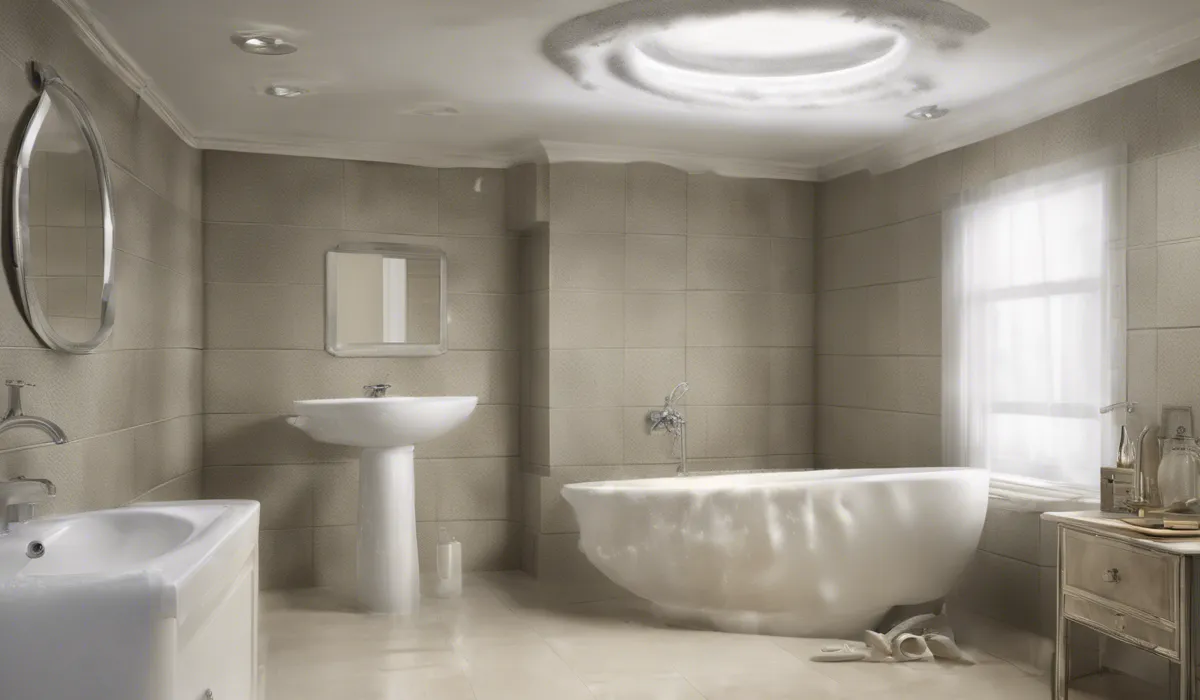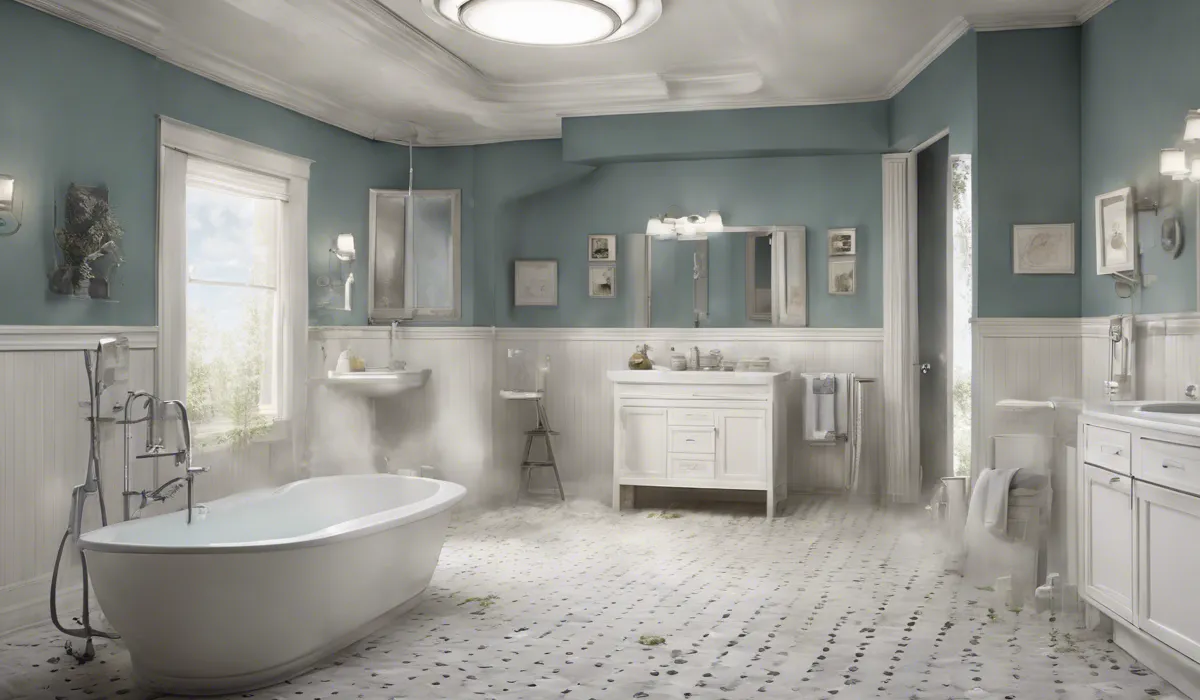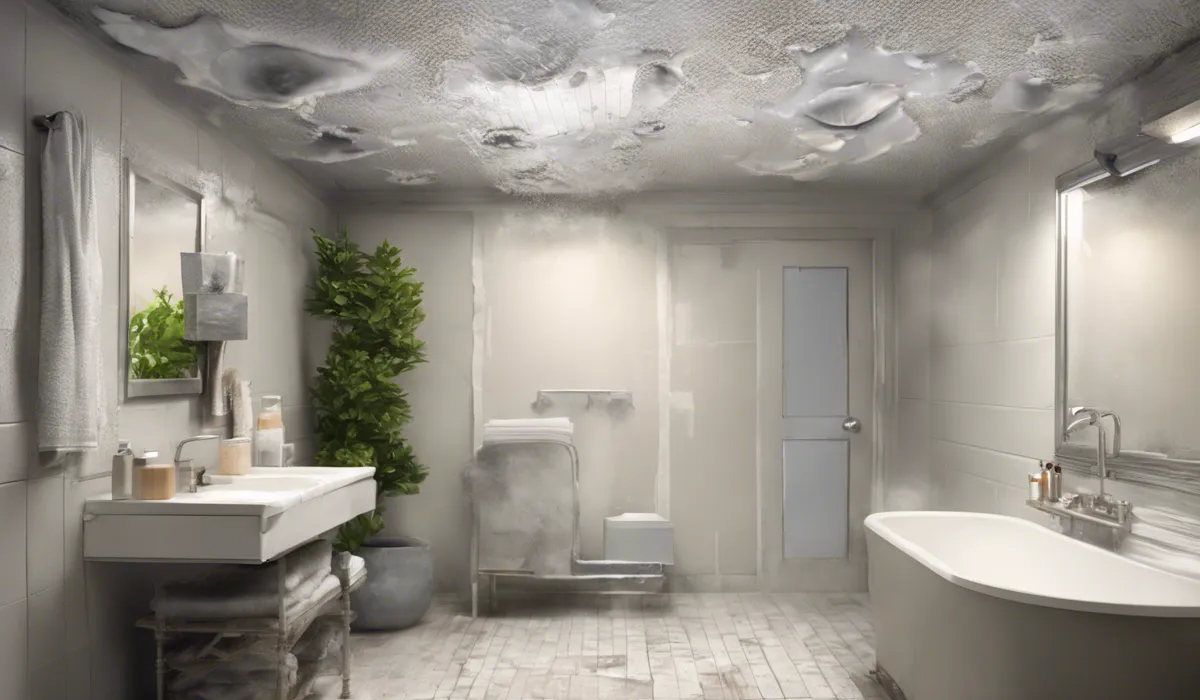To prevent mold on your bathroom ceiling, ensure good ventilation by using an exhaust fan during and after showers. Clean regularly with mold-resistant products, keep humidity levels low with a dehumidifier, and repair any leaks promptly. Paint the ceiling with mold-inhibiting paint for added protection.
Causes of Bathroom Ceiling Mold

What is Mold and What Types Thrive in Bathrooms?
Mold is a type of fungus that can grow indoors and outdoors. It thrives in damp, warm, and humid conditions.
In bathrooms, the most common types of mold include black mold (Stachybotrys chartarum), which is often found on damp walls, and mildew, which is a surface mold that grows in a flat pattern and is usually white or gray.
Both types can grow on your bathroom ceiling if the conditions are right.
Role of Moisture and Humidity in Fostering Mold
Moisture and humidity are mold’s best friends. Every time you take a hot shower, steam rises and increases the humidity in the room.
If this moisture stays in the air or settles on surfaces, it creates a perfect environment for mold to grow.
That’s why it’s so common to find mold in bathrooms—the conditions are often ideal for mold to thrive.
How Poor Ventilation Contributes to Mold Growth?
Proper air flow helps to dry out the bathroom after you’ve used it. Without good ventilation, moisture lingers on surfaces, including the ceiling.
This can lead to mold growth. A bathroom without a window or an exhaust fan is at high risk for mold problems because the air cannot circulate well.
Impact of Leaks on Bathroom Humidity
Leaky pipes, faucets, or a leaky roof can introduce extra moisture into your bathroom, even when it’s not in use.
This excess water can absorb into the ceiling and walls, creating a non-stop dampness that mold spores love.
Warm Temperatures and Mold Development
Warmth accelerates mold growth. Bathrooms are often the warmest rooms in the house due to hot showers and baths.
When you combine this warmth with moisture, you have a recipe for mold. It’s important to keep the temperature in check as well as the humidity.
Preventive Measures to Keep Your Bathroom Mold-Free

Effective Ventilation Techniques
To prevent mold, you need to keep the air moving. Using an exhaust fan during and after your shower pulls the moist air out of the room.
If you have a window, open it to let fresh air in and help dry out the room. For a high-tech solution, consider installing a humidity-sensing fan that turns on and off automatically to maintain proper ventilation.
Keeping Humidity Levels in Check
Maintaining the right humidity level is crucial. A dehumidifier can help, especially in regions with high humidity.
Use a hygrometer to keep track of the humidity level, and aim to keep it below 50%. This can make a big difference in preventing mold growth on your bathroom ceiling.
Cleaning and Maintenance to Ward Off Mold
Regularly cleaning your bathroom with mold-inhibiting products is essential. Pay special attention to ceiling corners and other areas where mold is likely to start growing.
Fix any leaks in your bathroom as soon as you spot them, and seal grout lines to keep water from seeping into the surfaces where mold could grow.
Remediation Strategies for Existing Mold on Bathroom Ceilings

Safety First: Preparing to Remove Mold
Before you start cleaning mold, protect yourself. Wear gloves and a mask to prevent touching or breathing in mold spores.
Make sure the room is well-ventilated to disperse any fumes from cleaning products and to prevent the spread of spores.
Choosing the Best Mold Cleaning Solutions
Different cleaning solutions can be effective against mold. Vinegar, bleach, and commercial mold removers all have their place.
Vinegar is a good natural option, while bleach is more aggressive. Commercial removers often combine ingredients for maximum effectiveness. Always follow the instructions on the label.
Techniques for Applying Mold Killers
When applying cleaning solutions, make sure they come into direct contact with the mold.
Use a spray bottle for even distribution and allow the solution to sit for the required amount of time to kill the mold. Afterward, wipe the area clean with a damp cloth to remove the dead mold spores.
Preventing Mold Spread During Cleanup
As you clean, take care not to spread mold spores around your home. Close the bathroom door and cover any air vents during cleanup to contain the spores.
After cleaning, wash your clothes and clean the equipment you used to prevent cross-contamination.
When to Seek Help from Mold Remediation Professionals?
If your mold issue is extensive, or if you’re dealing with toxic black mold, it’s time to call in professionals.
Look for certified mold remediation specialists who can safely remove the mold and take steps to prevent it from coming back. They will have the appropriate equipment and expertise to tackle the problem thoroughly.
Understanding the Mold Remediation Process
Professional mold removal involves several steps: assessing the extent of the mold, containing the area, removing the mold, and treating the space to prevent future growth.
Professionals also have access to specialized products and equipment that can more effectively clean and protect your bathroom ceiling.
FAQs About Preventing Mold on Bathroom Ceiling
How can I prevent mold from growing on my bathroom ceiling?
To prevent mold on your bathroom ceiling, use an exhaust fan during and for at least 20 minutes after showers, clean the ceiling with mold-resistant products regularly, and maintain low humidity levels with a dehumidifier.
What type of paint can help prevent bathroom ceiling mold?
Using mold-inhibiting paint specifically designed to resist moisture and mold growth can help protect your bathroom ceiling from mold.
Is it important to repair leaks to prevent bathroom ceiling mold?
Yes, promptly repairing any leaks is crucial as moisture from leaks significantly contributes to mold growth on bathroom ceilings.
Can a dehumidifier help in preventing mold on my bathroom ceiling?
Yes, a dehumidifier can be very effective in reducing moisture levels in the air, thereby helping to prevent mold growth on bathroom ceilings.
How often should I clean my bathroom to prevent mold on the ceiling?
Clean your bathroom regularly with mold-resistant products, focusing on weekly cleanings to effectively prevent mold buildup on the ceiling.
Final Thoughts
To stave off mold on bathroom ceilings, it’s crucial to maintain robust ventilation with an exhaust fan, engage in routine cleaning with mold-discouraging solutions, manage humidity through a dehumidifier, promptly address leaks, and apply mold-preventive paint for an extra layer of defense against mold growth.
